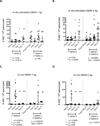Protection from secondary dengue virus infection in a mouse model reveals the role of serotype cross-reactive B and T cells
- PMID: 22131327
- PMCID: PMC3244532
- DOI: 10.4049/jimmunol.1102124
Protection from secondary dengue virus infection in a mouse model reveals the role of serotype cross-reactive B and T cells
Abstract
The four dengue virus (DENV) serotypes cause dengue fever and dengue hemorrhagic fever/dengue shock syndrome. Although severe disease has been associated with heterotypic secondary DENV infection, most secondary DENV infections are asymptomatic or result in classic DF. The role of cross-reactive immunity in mediating cross-protection against secondary heterotypic DENV infection is not well understood. DENV infection of IFN-α/β and IFN-γ receptor-deficient (AG129) mice reproduces key features of human disease. We previously demonstrated a role in cross-protection for pre-existing cross-reactive Abs, maintained by long-lived plasma cells. In this study, we use a sequential infection model, infecting AG129 mice with DENV-1, followed by DENV-2 6-8 wk later. We find that increased DENV-specific avidity during acute secondary heterotypic infection is mediated by cross-reactive memory B cells, as evidenced by increased numbers of DENV-1-specific cells by ELISPOT and higher avidity against DENV-1 of supernatants from polyclonally stimulated splenocytes isolated from mice experiencing secondary DENV-2 infection. However, increased DENV-specific avidity is not associated with increased DENV-specific neutralization, which appears to be mediated by naive B cells. Adoptive transfer of DENV-1-immune B and T cells into naive mice prior to secondary DENV-2 infection delayed mortality. Mice depleted of T cells developed signs of disease, but recovered after secondary DENV infection. Overall, we found that protective cross-reactive Abs are secreted by both long-lived plasma cells and memory B cells and that both cross-reactive B cells and T cells provide protection against a secondary heterotypic DENV infection. Understanding the protective immunity that develops naturally against DENV infection may help design future vaccines.
Figures







References
-
- Gubler DJ. Epidemic dengue/dengue hemorrhagic fever as a public health, social and economic problem in the 21st century. Trends Microbiol. 2002;10:100–103. - PubMed
-
- Guzman MG, Kouri GP, Bravo J, Soler M, Vazquez S, Morier L. Dengue hemorrhagic fever in Cuba, 1981: a retrospective seroepidemiologic study. Am. J. Trop. Med. Hyg. 1990;42:179–184. - PubMed
-
- Sabin AB. Research on dengue during World War II. Am. J. Trop. Med. Hyg. 1952;1:30–50. - PubMed
-
- Sangkawibha N, Rojanasuphot S, Ahandrik S, Viriyapongse S, Jatanasen S, Salitul V, Phanthumachinda B, Halstead SB. Risk factors in dengue shock syndrome: a prospective epidemiologic study in Rayong, Thailand. I. The 1980 outbreak. Am. J. Epidemiol. 1984;120:653–669. - PubMed
-
- Thein S, Aung MM, Shwe TN, Aye M, Zaw A, Aye K, Aye KM, Aaskov J. Risk factors in dengue shock syndrome. Am. J. Trop. Med. Hyg. 1997;56:566–572. - PubMed
Publication types
MeSH terms
Substances
Grants and funding
LinkOut - more resources
Full Text Sources
Other Literature Sources
Molecular Biology Databases
Miscellaneous

